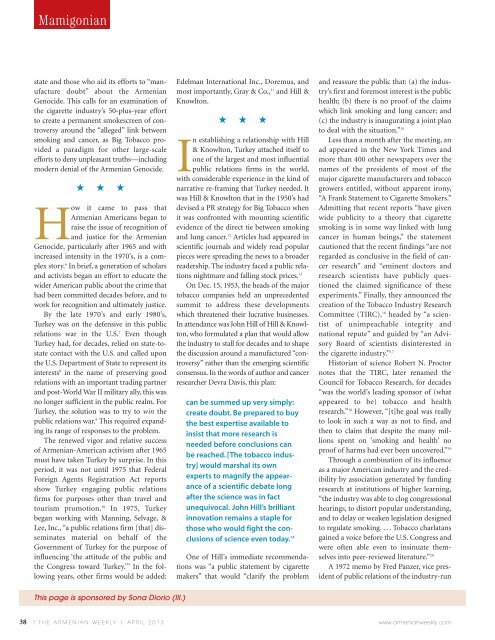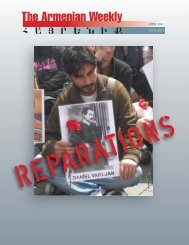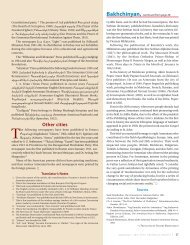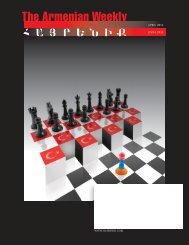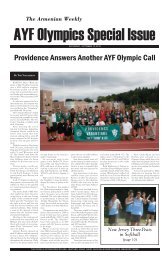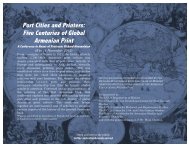You also want an ePaper? Increase the reach of your titles
YUMPU automatically turns print PDFs into web optimized ePapers that Google loves.
Mamigonian<br />
state and those who aid its efforts to “manufacture<br />
doubt” about the <strong>Armenian</strong><br />
Genocide. This calls for an examination of<br />
the cigarette industry’s 50-plus-year effort<br />
to create a permanent smokescreen of controversy<br />
around the “alleged” link between<br />
smoking and cancer, as Big Tobacco provided<br />
a paradigm for other large-scale<br />
efforts to deny unpleasant truths—including<br />
modern denial of the <strong>Armenian</strong> Genocide.<br />
2 2 2<br />
How it came to pass that<br />
<strong>Armenian</strong> Americans began to<br />
raise the issue of recognition of<br />
and justice for the <strong>Armenian</strong><br />
Genocide, particularly after 1965 and with<br />
increased intensity in the 1970’s, is a complex<br />
story. 6 In brief, a generation of scholars<br />
and activists began an effort to educate the<br />
wider American public about the crime that<br />
had been committed decades before, and to<br />
work for recognition and ultimately justice.<br />
By the late 1970’s and early 1980’s,<br />
Turkey was on the defensive in this public<br />
relations war in the U.S. 7 Even though<br />
Turkey had, for decades, relied on state-tostate<br />
contact with the U.S. and called upon<br />
the U.S. Department of State to represent its<br />
interests 8 in the name of preserving good<br />
relations with an important trading partner<br />
and post-World War II military ally, this was<br />
no longer sufficient in the public realm. For<br />
Turkey, the solution was to try to win the<br />
public relations war. 9 This required expanding<br />
its range of responses to the problem.<br />
The renewed vigor and relative success<br />
of <strong>Armenian</strong>-American activism after 1965<br />
must have taken Turkey by surprise. In this<br />
period, it was not until 1975 that Federal<br />
Foreign Agents Registration Act reports<br />
show Turkey engaging public relations<br />
firms for purposes other than travel and<br />
tourism promotion. 10 In 1975, Turkey<br />
began working with Manning, Selvage, &<br />
Lee, Inc., “a public relations firm [that] disseminates<br />
material on behalf of the<br />
Government of Turkey for the purpose of<br />
influencing ‘the attitude of the public and<br />
the Congress toward Turkey.’” In the following<br />
years, other firms would be added:<br />
Edelman International Inc., Doremus, and<br />
most importantly, Gray & Co., 11 and Hill &<br />
Knowlton.<br />
2 2 2<br />
In establishing a relationship with Hill<br />
& Knowlton, Turkey attached itself to<br />
one of the largest and most influential<br />
public relations firms in the world,<br />
with considerable experience in the kind of<br />
narrative re-framing that Turkey needed. It<br />
was Hill & Knowlton that in the 1950’s had<br />
devised a PR strategy for Big Tobacco when<br />
it was confronted with mounting scientific<br />
evidence of the direct tie between smoking<br />
and lung cancer. 12 Articles had appeared in<br />
scientific journals and widely read popular<br />
pieces were spreading the news to a broader<br />
readership. The industry faced a public relations<br />
nightmare and falling stock prices. 13<br />
On Dec. 15, 1953, the heads of the major<br />
tobacco companies held an unprecedented<br />
summit to address these developments<br />
which threatened their lucrative businesses.<br />
In attendance was John Hill of Hill & Knowl -<br />
ton, who formulated a plan that would allow<br />
the industry to stall for decades and to shape<br />
the discussion around a manufactured “controversy”<br />
rather than the emerging scientific<br />
consensus. In the words of author and cancer<br />
researcher Devra Davis, this plan:<br />
can be summed up very simply:<br />
create doubt. Be prepared to buy<br />
the best expertise available to<br />
insist that more research is<br />
needed before conclusions can<br />
be reached. [The tobacco industry]<br />
would marshal its own<br />
experts to magnify the appearance<br />
of a scientific debate long<br />
after the science was in fact<br />
unequivocal. John Hill’s brilliant<br />
innovation remains a staple for<br />
those who would fight the conclusions<br />
of science even today. 14<br />
One of Hill’s immediate recommendations<br />
was “a public statement by cigarette<br />
makers” that would “clarify the problem<br />
and reassure the public that: (a) the industry’s<br />
first and foremost interest is the public<br />
health; (b) t<strong>here</strong> is no proof of the claims<br />
which link smoking and lung cancer; and<br />
(c) the industry is inaugurating a joint plan<br />
to deal with the situation.” 15<br />
Less than a month after the meeting, an<br />
ad appeared in the New York Times and<br />
more than 400 other newspapers over the<br />
names of the presidents of most of the<br />
major cigarette manufacturers and tobacco<br />
growers entitled, without apparent irony,<br />
“A Frank Statement to Cigarette Smokers.”<br />
Admit ting that recent reports “have given<br />
wide publicity to a theory that cigarette<br />
smoking is in some way linked with lung<br />
cancer in human beings,” the statement<br />
cautioned that the recent findings “are not<br />
regarded as conclusive in the field of cancer<br />
research” and “eminent doctors and<br />
research scientists have publicly questioned<br />
the claimed significance of these<br />
experiments.” Finally, they announced the<br />
creation of the Tobacco Industry Research<br />
Committee (TIRC), 16 headed by “a scientist<br />
of unimpeachable integrity and<br />
national repute” and guided by “an Advi -<br />
sory Board of scientists disinterested in<br />
the cigarette industry.” 17<br />
Historian of science Robert N. Proctor<br />
notes that the TIRC, later renamed the<br />
Council for Tobacco Research, for decades<br />
“was the world’s leading sponsor of (what<br />
appeared to be) tobacco and health<br />
research.” 18 However, “[t]he goal was really<br />
to look in such a way as not to find, and<br />
then to claim that despite the many millions<br />
spent on ‘smoking and health’ no<br />
proof of harms had ever been uncovered.” 19<br />
Through a combination of its influence<br />
as a major American industry and the credibility<br />
by association generated by funding<br />
research at institutions of higher learning,<br />
“the industry was able to clog congressional<br />
hearings, to distort popular understanding,<br />
and to delay or weaken legislation designed<br />
to regulate smoking. . . . Tobacco charlatans<br />
gained a voice before the U.S. Congress and<br />
were often able even to insinuate themselves<br />
into peer-reviewed literature.” 20<br />
A 1972 memo by Fred Panzer, vice president<br />
of public relations of the industry-run<br />
This page is sponsored by Sona Diorio (Ill.)<br />
38<br />
| THE ARMENIAN WEEKLY | APRIL 2013<br />
www.armenianweekly.com


